
Toroidal Saddle Lattices
This 3-parameter family of embedded doubly periodic surfaces
is parametrized by tori. The last example on this page
which input file is named FST.am has all 3 parameters.
The other examples are more symmetric surfaces of this family.
The first two surfaces are only 1-paramter families.
The names of their input files are FsymSTsymP.am respective
FsymSTsymL.am.
The third and fourth surfaces are 2-parameter families.
Their input files are named FsymST.am and FSTsymL.am.
The pictures on the left show the surfaces itself and
the pictures on the right show the conjugate surfaces.
The most symmetric examples look like a fence of Scherk's saddle towers.
The saddle towers are glued together in such a way
that the horizontal saddle points on neighbouring towers are
on the same levels.
Two adjacent Scherk towers can be adjusted so that neighbouring handles
are either orthogonal or parallel.
The Scherk ends of the two most symmetric families are
orthogonal to the period-lattice of the surfaces.
Fence of less symmetric saddle towers with planar geodesic
In this family the neighbouring handles of adjacent saddle towers are
orthogonal, and there are vertical symmetry planes between
adjacent Scherk towers.
The only parameter of the family is the conformal parameter of the
underlying tori.
Variation of that parameter changes the distance between neighbouring
Scherk ends.
The conjugate of this surface looks roughly the same,
in genaral only the distance between neighbourings ends is different.
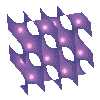
How do I get the complete fundamental domain of translation
when using GRAPE?
First of all you should load the grid-status-file to see the computed
piece of the surface.
This piece is bounded by two planar geodesic lines and two straight lines.
Now reflect the surface on each planar geodesic line.
Then you should read in the patch-status-file.
After two additional 180-degree rotations around two perpendicular
straight lines you see the fundamental domain of translation of this
surface.
If you want to see a larger part of the surface,
you can continue to rotate around straight lines.
Fence of symmetric saddle towers with straight line
In this family the neighbouring handles of adjacent saddle towers are
parallel, and there are vertical straight lines between
adjacent Scherk towers.
The only parameter of the family is the conformal parameter of the
underlying tori.
Variation of that parameter changes the distance between neighbouring
Scherk ends.
The conjugate of this surface is a family of parallel planes which are
connected by handles which are arranged in a rectangular checkerboard pattern
along a orthogonal plane.
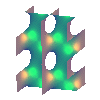
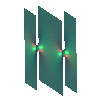
How do I get the complete fundamental domain of translation
when using GRAPE?
First of all you should load the grid-status-file to see the computed
piece of the surface.
This piece is bounded by three planar geodesic lines and one straight line.
Now reflect the surface on each planar geodesic line.
Then you should read in the patch-status-file.
After an additional 180-degree rotation around a straight line
you see the fundamental domain of translation of this surface.
If you want to see a larger part of the surface,
you can continue to rotate around straight lines.
Fence of less symmetric saddle towers with straight line
This family is a deformation of the just before described surface.
Now the Scherk ends are no longer orthogonal
to the plane of the period-lattice.
You can compare this two families to the singly periodic Scherk tower and
the less symmetric Scherk towers with four ends (k=2).
Also see Scherk towers and its deformations.
In the conjugate family the parallel planes are sheared.
Because of this the handles are no longer orthogonal to the planes.
These surfaces look like doubly periodic versions of
Riemann's surfaces.
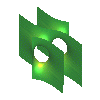

How do I get the complete fundamental domain of translation
when using GRAPE?
First of all you should load the grid-status-file to see the computed
piece of the surface.
This piece is bounded by two planar geodesic lines, one straight line
and an other line which contains a point
where 180-degree rotation around the normal of the surface is a symmetry.
Now you have to find the point with rotational symmetry.
After the rotation reflect the surface on both planar geodesic lines,
and rotate around a straight line.
If you read in the patch-status-file,
you see the fundamental domain of translation of this surface.
If you want to see a larger part of the surface,
you can continue to rotate around straight lines.
Fence of symmetric saddle towers
This family is a deformation of the first discribed surface
into the second one.
You can imagine that one Scherk tower of the surface is fixed
and that its neighbour tower slides up or down.
In this case the Scherk ends are orthogonal to the period-lattice.
The conjugate is a deformation between the conjugate surfaces of the
first two examples.
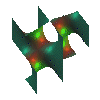
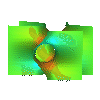
How do I get the complete fundamental domain of translation
when using GRAPE?
First of all you should load the grid-status-file to see the computed
piece of the surface.
This piece is bounded by two straight lines and three other lines.
Now you have to find the point with 180-degree rotational symmetry
around a normal of the surface.
This point is contained in the line opposite to the Scherk end.
After the rotation you have to carry out a reflection on a branch point.
Here you can recognize the branch points easily.
The branch points are the points where the parameter lines intersect not
orthogonal.
Then you should read in the patch-status-file.
After an additional 180-degree rotation around a straight line
you see the fundamental domain of translation of this surface.
If you want to see a larger part of the surface,
you can continue to rotate around straight lines.
Fence of less symmetric saddle towers
In this 3-parameter family adjacent saddle towers can slide up or down and
the Scherk ends are in general not orthogonal to the period-lattice.
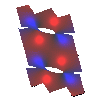

How do I get the complete fundamental domain of translation
when using GRAPE?
This time you only have to carry out a single point inversion at a branchpoint.
For more details see the paper
"Doppelt periodische elliptische Minimalflächen"
(Warning: A click on this link starts a data transfer of 4.7 MB
and you need 22.3 MB free space on your local tmp-directory to get the paper!).
 Return to the surface list.
Return to the surface list.
 Return to the project list.
Return to the project list.
 Go back to the main menu.
Go back to the main menu.
ct@nicolai.iam.uni-bonn.de










 Return to the surface list.
Return to the surface list.
 Return to the project list.
Return to the project list.
 Go back to the main menu.
Go back to the main menu.